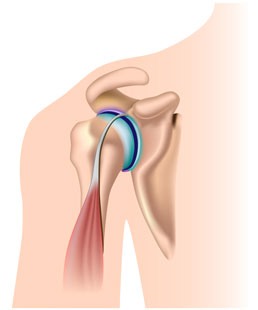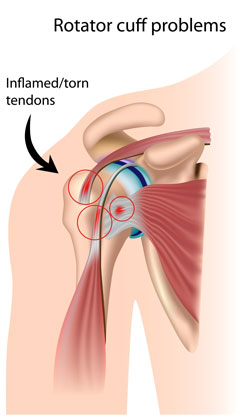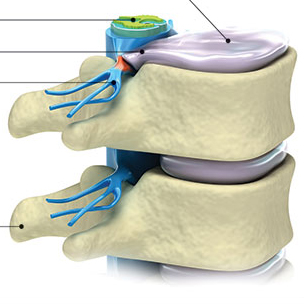Back to Shoulder Pain Overview
Causes of Shoulder Pain
 Many shoulder injuries are caused by athletic activities that involve excessive, repetitive, overhead motion, such as swimming, tennis, pitching, and weightlifting. But these injuries can also occur during everyday activities such washing walls, hanging curtains, and even gardening.
Many shoulder injuries are caused by athletic activities that involve excessive, repetitive, overhead motion, such as swimming, tennis, pitching, and weightlifting. But these injuries can also occur during everyday activities such washing walls, hanging curtains, and even gardening.
If you are experiencing pain in your shoulder, ask yourself these questions:
- Is your shoulder stiff? Can you rotate your arm in all the normal positions?
- Does it feel like your shoulder could pop out or slide out of the socket?
- Do you lack the strength in your shoulder to carry out your daily activities?
If you answered “yes” to any of these questions, you should contact us for help in determining the severity of the problem. Our board-certified orthopedic surgeons are experts at diagnosing and treating shoulder pain. Our compassionate staff has specific expertise in the broad spectrum of shoulder conditions and uses the latest in surgical and non-surgical techniques.
Common Conditions
- AC Separation
- Frozen Shoulder
- Glenohumeral (Shoulder) Arthritis
- Labral Tears
- Multidirectional Instablility
- Rotator Cuff Impingement
- Rotator Cuff Tear
- Shoulder Dislocation
- Shoulder Trauma

Common causes of pain
Rather than bones, many shoulder problems involve the soft tissues, muscles, ligaments, and tendons. A majority of these problems fall into three major categories:
- Tendinitis/bursitis
- Injury/instability
- Arthritis
- Other much more rare causes of shoulder pain are tumors, infection and nerve-related problems.
Tendinitis
A tendon is a cord which connects muscle to bone or other tissue. Similar to the wearing process on the sole of a shoe which eventually splits from overuse, most tendinitis is a result of the wearing process that takes place over a period of years. Typically, tendinitis is one of several types:
- Acute tendinitis following some overuse problem such as excessive ball throwing and other sports- or work-related activities.
- Chronic tendinitis which can be attributed to degenerative disease or repetitive wear and tear due to age.
- The splitting and tearing of tendons which may result from acute injury or degenerative changes in the tendons due to advancing age. Rotator cuff injuries are among the most common of these disorders. The rotator cuff is composed of muscles and their tendons which provides shoulder motion and stability.
Dislocated Shoulder
If you have a dislocated shoulder, it can either be partially dislocated or fully dislocated. This can happen from falling or from contact sports like rugby or football. A hard hit pulls the arm out of the shoulder socket. It will swell up, become numb and weak, and bruise. A doctor will pop it back into place and then follow up orthopaedic care will be necessary until it regains stability.
Rotator Cuff Tears
 As the most flexible joint in the body, the shoulder is capable of performing a wide range of activities. However, with this incredible range of motion, it is at high risk for overuse and the joint is prone to tearing over time causing a great deal of pain. Since a rotator cuff injury stems from a ligament or muscle tear in the shoulder, improper posture and lifting, falling down, or repetitive strain on the shoulder can all lead to rotator cuff tears.
As the most flexible joint in the body, the shoulder is capable of performing a wide range of activities. However, with this incredible range of motion, it is at high risk for overuse and the joint is prone to tearing over time causing a great deal of pain. Since a rotator cuff injury stems from a ligament or muscle tear in the shoulder, improper posture and lifting, falling down, or repetitive strain on the shoulder can all lead to rotator cuff tears.
A rotator cuff tear is particularly common among those over the age of 40 since this is when collagen does not produce itself as fast in the body and calcium deposits settle in the shoulder joint though it can affect people of any age.
Treating a rotator cuff nonsurgically may be appropriate depending on the severity of the injury. In many cases, the best thing to do is administer RICE (rest from the activity causing the pain, apply ice to the injured area, compress the injured area, and elevate the injured area above the heart to limit blood flow).
When it hurts to sleep on the affected shoulder, lifting the arms is uncomfortable, the pain resides in the dominant arm or the affected shoulder continues to make noises, it is a good idea have a doctor give you an examination.
Bursitis
In some cases, excessive use of the shoulder leads to inflammation and swelling of a bursa, a condition called bursitis. Bursas are often described as fluid-filled sacs located around the joints which lessen the friction caused by movement of the shoulder. Bursitis ususally occurs in association with rotator cuff tendinitis. Sometimes the many tissues in the shoulder become inflamed and painful, which in turn may limit the use of the shoulder. The joint may stiffen as a result, a condition known as a "frozen shoulder." The good news is that with appropriate care, this condition will usually resolve itself.
Injury/Instability
Sometimes the bones in one of the shoulder joints move (or, in an injury, are forced) out of their normal position. This condition, instability, can result in dislocation of one of the joints in the shoulder. Recurring dislocations, which may be partial or complete, cause pain and unsteadiness when you raise your arm or move it away from your body. When you lift your rm over your head, the shoulder may feel as if it is slipping out of place or an uncomfortable, unusual feeling that some people refer to as having a "dead" arm.
 Arthritis
Arthritis
Shoulder pain may also result from arthritis. There are many types of arthritis, but generally it involves wear and tear changes with inflammation of the joint, causing swelling, pain and stiffness. Arthritis may be attributed to sports or work injuries.
People will often avoid shoulder movements in an attempt to lessen the pain arising from these conditions. Unfortunately, this can lead to a tightening or stiffening of the soft tissue parts of the joint, resulting in a painful restriction of motion.








